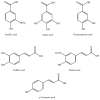Antibacterial Effects of Cinnamon: From Farm to Food, Cosmetic and Pharmaceutical Industries
- PMID: 26378575
- PMCID: PMC4586554
- DOI: 10.3390/nu7095359
Antibacterial Effects of Cinnamon: From Farm to Food, Cosmetic and Pharmaceutical Industries
Abstract
Herbs and spices have been used since ancient times, because of their antimicrobial properties increasing the safety and shelf life of food products by acting against foodborne pathogens and spoilage bacteria. Plants have historically been used in traditional medicine as sources of natural antimicrobial substances for the treatment of infectious disease. Therefore, much attention has been paid to medicinal plants as a source of alternative antimicrobial strategies. Moreover, due to the growing demand for preservative-free cosmetics, herbal extracts with antimicrobial activity have recently been used in the cosmetic industry to reduce the risk of allergies connected to the presence of methylparabens. Some species belonging to the genus Cinnamomum, commonly used as spices, contain many antibacterial compounds. This paper reviews the literature published over the last five years regarding the antibacterial effects of cinnamon. In addition, a brief summary of the history, traditional uses, phytochemical constituents, and clinical impact of cinnamon is provided.
Keywords: antibacterial activity; cinnamaldehyde; cinnamon; eugenol; infectious diseases; spice.
Figures
Similar articles
-
Phytochemical profiles and antimicrobial activity of aromatic Malaysian herb extracts against food-borne pathogenic and food spoilage microorganisms.J Food Sci. 2014 Apr;79(4):M583-92. doi: 10.1111/1750-3841.12419. Epub 2014 Mar 25. J Food Sci. 2014. PMID: 24666004
-
Foodborne Pathogens Prevention and Sensory Attributes Enhancement in Processed Cheese via Flavoring with Plant Extracts.J Food Sci. 2015 Dec;80(12):M2886-91. doi: 10.1111/1750-3841.13138. Epub 2015 Nov 5. J Food Sci. 2015. PMID: 26540146
-
Antibacterial properties and major bioactive components of cinnamon stick (Cinnamomum burmannii): activity against foodborne pathogenic bacteria.J Agric Food Chem. 2007 Jul 11;55(14):5484-90. doi: 10.1021/jf070424d. Epub 2007 Jun 13. J Agric Food Chem. 2007. PMID: 17567030
-
Antibacterial and Antifungal Activities of Spices.Int J Mol Sci. 2017 Jun 16;18(6):1283. doi: 10.3390/ijms18061283. Int J Mol Sci. 2017. PMID: 28621716 Free PMC article. Review.
-
Antibacterial mechanisms of cinnamon and its constituents: A review.Microb Pathog. 2018 Jul;120:198-203. doi: 10.1016/j.micpath.2018.04.036. Epub 2018 Apr 24. Microb Pathog. 2018. PMID: 29702210 Review.
Cited by
-
The dark side of beauty: an in-depth analysis of the health hazards and toxicological impact of synthetic cosmetics and personal care products.Front Public Health. 2024 Aug 26;12:1439027. doi: 10.3389/fpubh.2024.1439027. eCollection 2024. Front Public Health. 2024. PMID: 39253281 Free PMC article. Review.
-
Active Polysaccharide-Based Films Incorporated with Essential Oils for Extending the Shelf Life of Sliced Soft Bread.Molecules. 2024 Sep 30;29(19):4664. doi: 10.3390/molecules29194664. Molecules. 2024. PMID: 39407592 Free PMC article.
-
Antibiofilm activities of the cinnamon extract against Vibrio parahaemolyticus and Escherichia coli.Arch Microbiol. 2021 Jan;203(1):125-135. doi: 10.1007/s00203-020-02008-5. Epub 2020 Aug 9. Arch Microbiol. 2021. PMID: 32772125
-
In vitro Synergy of Polyphenolic Extracts From Honey, Myrtle and Pomegranate Against Oral Pathogens, S. mutans and R. dentocariosa.Front Microbiol. 2020 Jul 24;11:1465. doi: 10.3389/fmicb.2020.01465. eCollection 2020. Front Microbiol. 2020. PMID: 32849317 Free PMC article.
-
Antibacterial Activity of Commercial Phytochemicals against Aeromonas Species Isolated from Fish.Pathogens. 2019 Sep 8;8(3):142. doi: 10.3390/pathogens8030142. Pathogens. 2019. PMID: 31500367 Free PMC article.
References
-
- Alinezhad H., Azimi R., Zare M., Ebrahimzadeh M.A., Eslami S., Nabavi S.F., Nabavi S.M. Antioxidant and Antihemolytic Activities of Ethanolic Extract of Flowers, Leaves, and Stems of Hyssopus officinalis L. Var. angustifolius. Int. J. Food Prop. 2013;16:1169–1178. doi: 10.1080/10942912.2011.578319. - DOI
-
- Curti V., Capelli E., Boschi F., Nabavi S.F., Bongiorno A.I., Habtemariam S., Nabavi S.M., Daglia M. Modulation of human miR-17–3p expression by methyl 3-O-methyl gallate as explanation of its in vivo protective activities. Mol. Nutr. Food Res. 2014;58:1776–1784. doi: 10.1002/mnfr.201400007. - DOI - PubMed
-
- Nabavi S.F., Nabavi S.M., Habtemariam S., Moghaddam A.H., Sureda A., Jafari M., Latifi A.M. Hepatoprotective effect of gallic acid isolated from Peltiphyllum peltatum against sodium fluoride-induced oxidative stress. Ind. Crop. Prod. 2013;44:50–55. doi: 10.1016/j.indcrop.2012.10.024. - DOI
Publication types
MeSH terms
Substances
LinkOut - more resources
Full Text Sources
Other Literature Sources
Medical
Molecular Biology Databases



